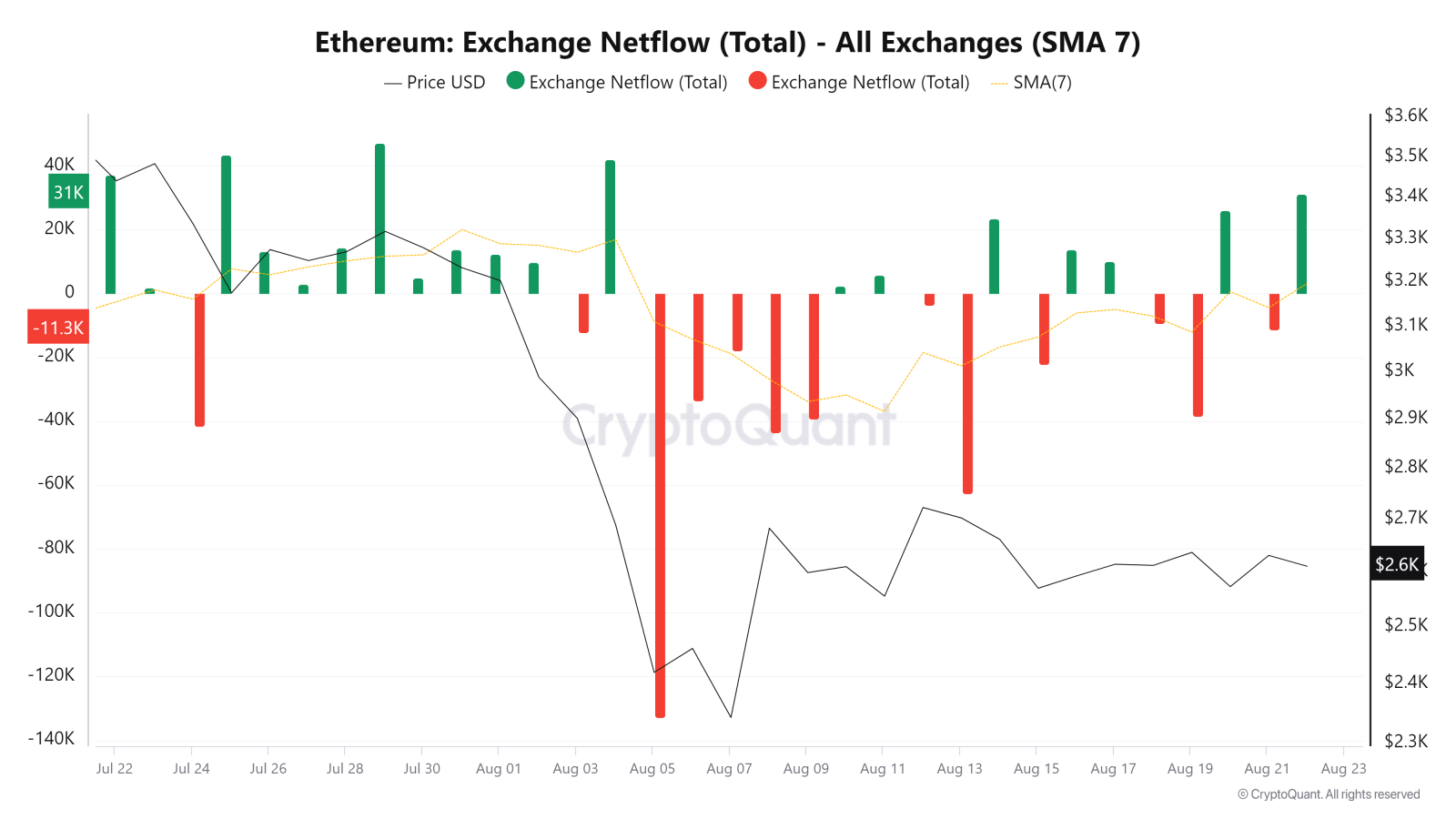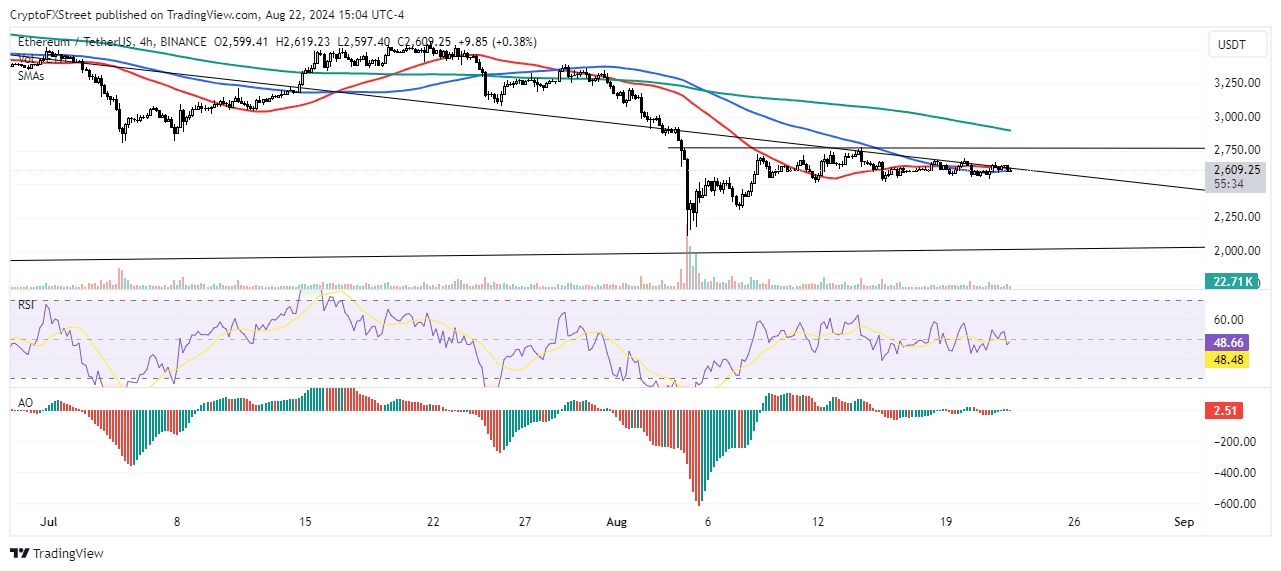Ethereum ETFs record longest outflow streak, exchange net flow indicates mounting selling pressure

- Ethereum ETFs record their longest outflow streak with five days of consecutive negative flows.
- Ethereum exchange net flow has increased to 31K ETH, its highest since the market crash on August 5.
- Vitalik Buterin says Ethereum is growing based on several key metrics.
- Ethereum technical indicators suggest a range-bound movement amid mixed sentiments from futures traders and fund investors.
Ethereum (ETH) is down 1% on Thursday as its ETF and exchange net flows suggest that sellers dominate the market. Despite the selling pressure, Ethereum co-founder Vitalik Buterin shared a post depicting its growth across several metrics.
Daily digest market movers: Ethereum ETF five-day outflow streak, positive exchange net flows, Vitalik’s metrics
Ethereum ETFs recorded its longest negative flows streak — five consecutive days — on Wednesday after posting outflows of $18 million.
The flows were spearheaded by outflows of $31.1 million in Grayscale’s ETHE, bringing its cumulative outflows since launch to over $2.5 billion. ETHA accompanied its milestone of over $1 billion in cumulative net inflows with zero flows on Wednesday.
With the consistent negative flows, Ethereum ETFs could record another week of net outflows as cumulative flows since Monday have amounted to $38 million in outflows.
A similar trend is occurring with ETH exchange flows. Unlike ETF flows, positive exchange net flows indicate selling pressure is rising and may lead to price declines.
Ethereum net exchange inflow increased to 31K ETH on Thursday, its highest since the market crash on August 5. The 7-day moving average exchange netflow has also been rising since August 11.

ETH Exchange Net Flow
Meanwhile, Ethereum co-founder Vitalik Buterin shared an X post with several metrics suggesting that ETH has continued on its growth path. Some of the points he highlighted include the following:
- Increased staking decentralization.
- Improvement in cross-L2 wallet user experience (UX).
- More clarity on account abstraction roadmap.
- Mature zero-knowledge (ZK) tooling and many others.
“The fundamentals for Ethereum are actually crazy strong right now,” noted Buterin.
Ethereum has gotten stronger:
* Under $0.01 txfees on L2
* Two EVM L2s (@Optimism @arbitrum) now at stage 1
* Cross-L2 wallet UX has improved a lot (eg. no more manually switching networks), though still a long way to go
* Much more powerful and mature ZK tooling making life… pic.twitter.com/4jQGeZ3qEA— vitalik.eth (@VitalikButerin) August 22, 2024
ETH technical analysis: Ethereum could continue range-bound movement
Ethereum is trading around $2,610 on Thursday, down 1% on the day. In the past 24 hours, ETH has seen $31.34 million in liquidations, with long and short liquidations accounting for $24.1 million and $7.24 million, respectively.
Ethereum is consolidating on the 4-hour chart, where the 200-day Simple Moving Average (SMA) serves as support to prevent further price declines. Before prices could rally, ETH needs to overcome the $2,775 resistance which — coupled with the 50-day SMA — has prevented any upward attempt.

ETH/USDT 4-hour chart
The ETH Long/Short Ratio at 0.96 shows sellers dominate the market. Still, relatively strong buying pressure from Coinbase and Ethereum Funds investors, as evidenced by their premiums of 0.024 and 0.38, respectively, has kept prices on a horizontal trend.
ETH will likely remain range-bound with a bias toward the downside, as depicted by a key trendline extending from May 29 to September 27.
The Relative Strength Index (RSI) has moved below its midline at 48, indicating neutrality in momentum. The Awesome Oscillator (AO) also aligns with the neutral sentiment, posting short bars just shy above zero.
In the short term, ETH could rise to $2,666 to liquidate positions worth $65 million.
Ethereum FAQs
What is Ethereum?
Ethereum is a decentralized open-source blockchain with smart contracts functionality. Serving as the basal network for the Ether (ETH) cryptocurrency, it is the second largest crypto and largest altcoin by market capitalization. The Ethereum network is tailored for scalability, programmability, security, and decentralization, attributes that make it popular among developers.
What blockchain technology does Ethereum use?
Ethereum uses decentralized blockchain technology, where developers can build and deploy applications that are independent of the central authority. To make this easier, the network has a programming language in place, which helps users create self-executing smart contracts. A smart contract is basically a code that can be verified and allows inter-user transactions.
What is staking?
Staking is a process where investors grow their portfolios by locking their assets for a specified duration instead of selling them. It is used by most blockchains, especially the ones that employ Proof-of-Stake (PoS) mechanism, with users earning rewards as an incentive for committing their tokens. For most long-term cryptocurrency holders, staking is a strategy to make passive income from your assets, putting them to work in exchange for reward generation.
Why did Ethereum shift from Proof-of-Work to Proof-of-Stake?
Ethereum transitioned from a Proof-of-Work (PoW) to a Proof-of-Stake (PoS) mechanism in an event christened “The Merge.” The transformation came as the network wanted to achieve more security, cut down on energy consumption by 99.95%, and execute new scaling solutions with a possible threshold of 100,000 transactions per second. With PoS, there are less entry barriers for miners considering the reduced energy demands.




 Bitcoin
Bitcoin  Ethereum
Ethereum  Tether
Tether  USDC
USDC  Dogecoin
Dogecoin  TRON
TRON  Cardano
Cardano  Stellar
Stellar  Chainlink
Chainlink  Hedera
Hedera  Bitcoin Cash
Bitcoin Cash  Litecoin
Litecoin  LEO Token
LEO Token  Monero
Monero  Cronos
Cronos  Dai
Dai  Ethereum Classic
Ethereum Classic  OKB
OKB  Algorand
Algorand  VeChain
VeChain  Cosmos Hub
Cosmos Hub  Gate
Gate  KuCoin
KuCoin  Stacks
Stacks  Tezos
Tezos  Theta Network
Theta Network  IOTA
IOTA  Tether Gold
Tether Gold  Zcash
Zcash  TrueUSD
TrueUSD  NEO
NEO  Polygon
Polygon  Decred
Decred  Dash
Dash  Ravencoin
Ravencoin  Qtum
Qtum  Basic Attention
Basic Attention  Zilliqa
Zilliqa  0x Protocol
0x Protocol  Synthetix Network
Synthetix Network  Holo
Holo  Siacoin
Siacoin  DigiByte
DigiByte  Enjin Coin
Enjin Coin  Ontology
Ontology  Nano
Nano  Status
Status  Hive
Hive  Waves
Waves  Lisk
Lisk  Steem
Steem  Numeraire
Numeraire  Pax Dollar
Pax Dollar  BUSD
BUSD  Huobi
Huobi  NEM
NEM  OMG Network
OMG Network  Bitcoin Gold
Bitcoin Gold  Ren
Ren  Bitcoin Diamond
Bitcoin Diamond  Augur
Augur